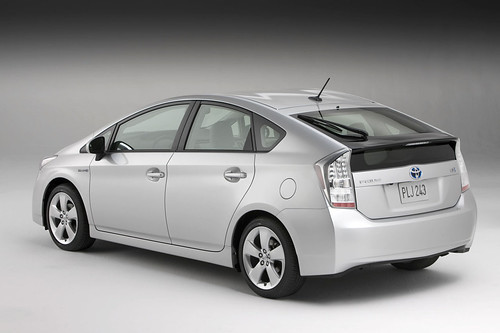The chase for stimulus dollars now includes a sprint up Capitol Hill, quite literally.
The stimulus package has $2.5 billion for batteries and hybrids, and one of the many companies seeking a slice, AFS Trinity, arrived in Washington on Sunday with two Saturn Vue S.U.V.’s — “crossover” vehicles that General Motors sells as hybrids, but which AFS Trinity has extensively modified as plug-in hybrids.
The company is inviting members of Congress and their employees to drive them, and a favorite stretch is a steep hill up Constitution Avenue on the north side of the Capitol building.
AFS Trinity, of Bellevue, Wash., added two kinds of batteries to the Vue: A bank of lithium-ion batteries with 16 kilowatt-hours of usable storage (enough to go more than 40 miles), and a small bundle of ultra-capacitors — devices that hold only a little bit of energy, but can deliver or accept it very quickly.
The ultra-capacitors smooth out the start-and-stop flow of that comes with everyday driving, buffering the main batteries in a way that extends their lifetime. And they deliver real “vroom,” even though the electric drivetrain is silent.
The original Saturn comes with a four-cylinder, 170-horsepower gasoline engine. As a plug-in, normal practice would be to charge the battery overnight and drive around without the engine for the first 40 miles or so, but AFS Trinity put a button near the cigarette lighter. Push it, and the electric motor kicks in, creating a 370-horsepower street rod.
The vehicle can also run in gasoline–only mode. And it can run in something called “charge-depleting mode,’’ in which it uses electricity from the battery to assist the gasoline engine. In that mode, it gets 68 miles a gallon, the company said, and it can operate that way for 60 miles — far longer than most peoples’ daily drive.
From the outside, the prototypes look like ordinary Saturn Vue’s, except for the big lettering on the side that announce them as 150-mile-per-gallon vehicles (that number assumes the owner drives it in all-electric mode most of the time).
Edward W. Furia, AFS Trinity’s chief executive, is looking for $40 million to build 100 cars, probably for use by a government agency like the Postal Service, then $200 million for the next thousand vehicles. Eventually he would like $1.3 billion to re-tool a GM factory to produce hundreds of thousands of plug-in hybrids. The company’s long-term plan is to produce vehicles with a price premium of $8,000 above the cost of the regular, nonhybrid version. If it could reach that point, the consumer’s extra investment might be quite small, after federal and state tax credits.







